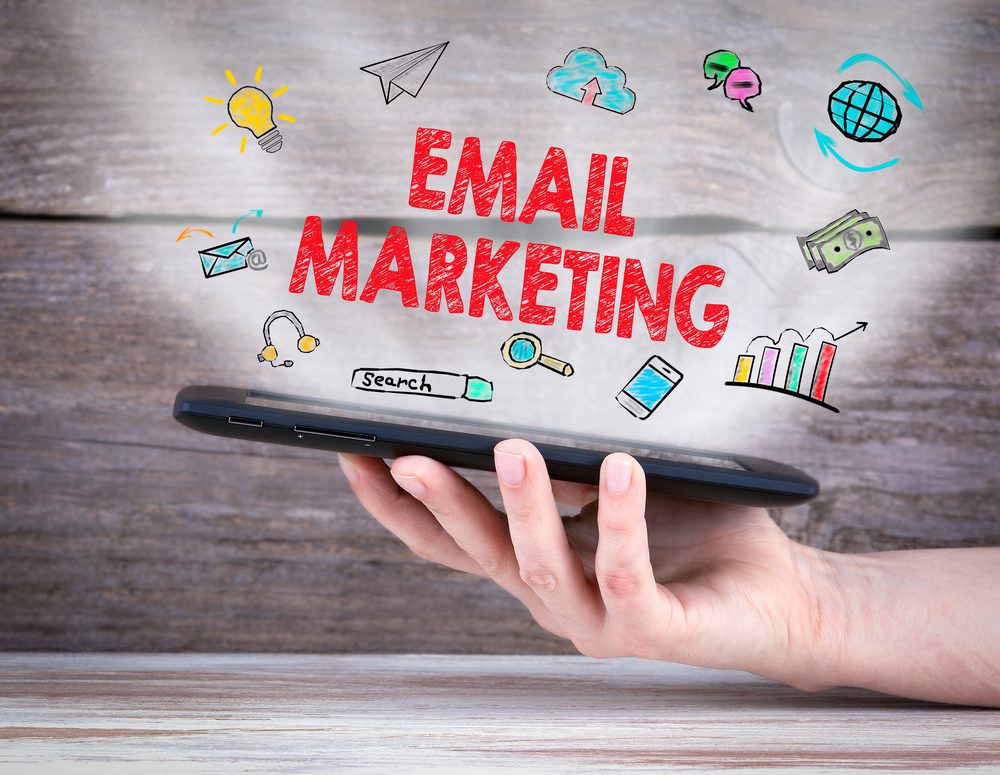
5 Email Marketing Mistakes You’re Probably Making Too Often
Marketing is without a doubt one of the most important parts of running a business. It is how you attract new customers and get your products or services out to the masses.
Most companies, according to the U.S Small Business Administration, should spend around 7-8 percent of their gross revenue on marketing. This is likely to be one of your largest operational costs. If you’re in a competitive industry, this number can be much higher, of course.
Although the TV, newspaper and radio used to dominate the world of marketing, it is now dominated by the internet. Specifically, email marketing has long been one of the most fruitful ways for companies to increase sales and reach a larger audience. It features many benefits that still make it viable years after its origins. While new methods of marketing have come along, email is still very viable.
However, for all of the benefits that email marketing can bring a company or individuals, there are some common mistakes that can be very costly. Having these mistakes within your email marketing strategy can lead to unsuccessful campaigns and can waste a lot of money. They can also be hard to miss if you don’t know what to look for.
In order to help ensure you are able to avoid these mistakes, we have decided to craft an article about some of the most harmful and common ones that you could encounter.
 Unfortunately, going through and manually checking all of your emails to ensure they are real is simply not possible for most people. It would take forever and the actual steps involved would be quite cumbersome to undertake. However, verifying and validating your email list is incredibly important, so what are you to do?
Thankfully, there are services and companies that can validate and verify your emails for you (you can learn more here). These will go through your email list and analyze every address and make sure it is valid and can have emails delivered to it. These pieces of software go through many different steps and stages to make sure your email list is 100% deliverable and optimized.
Unfortunately, going through and manually checking all of your emails to ensure they are real is simply not possible for most people. It would take forever and the actual steps involved would be quite cumbersome to undertake. However, verifying and validating your email list is incredibly important, so what are you to do?
Thankfully, there are services and companies that can validate and verify your emails for you (you can learn more here). These will go through your email list and analyze every address and make sure it is valid and can have emails delivered to it. These pieces of software go through many different steps and stages to make sure your email list is 100% deliverable and optimized.
 While it would be lovely if everyone who got or opened your email made a purchase or clicked a link, that is not the case. Generally, only a small portion of your subscribers will even open the email, much less provide your desired conversion. As a result, you need to ensure people not only click your email, but convert.
One of the best ways to do this is to utilize a call-to-action (often referred to as a CTA). A call-to-action has the goal of prompting someone to do something such as asking them to click a link, like a profile, check out your shop or dozens of other things. Emails with calls to action are more likely to be clicked through than emails that don’t have them.
Every email you send should have a relevant purpose and a call to action that helps guide customers or subscribers to a conversion. Of course, be sure to avoid using too many CTAs in your emails, as that can seem spammy and disingenuous. Also, be sure that the CTA is relevant to the email content itself.
If you’re organizing an event, the CTA should be about signing up for the event, not for them to check out your Instagram. The key is to ensure everything remains relevant and flows well.
While it would be lovely if everyone who got or opened your email made a purchase or clicked a link, that is not the case. Generally, only a small portion of your subscribers will even open the email, much less provide your desired conversion. As a result, you need to ensure people not only click your email, but convert.
One of the best ways to do this is to utilize a call-to-action (often referred to as a CTA). A call-to-action has the goal of prompting someone to do something such as asking them to click a link, like a profile, check out your shop or dozens of other things. Emails with calls to action are more likely to be clicked through than emails that don’t have them.
Every email you send should have a relevant purpose and a call to action that helps guide customers or subscribers to a conversion. Of course, be sure to avoid using too many CTAs in your emails, as that can seem spammy and disingenuous. Also, be sure that the CTA is relevant to the email content itself.
If you’re organizing an event, the CTA should be about signing up for the event, not for them to check out your Instagram. The key is to ensure everything remains relevant and flows well.
 Your subscribers may have opted into your email list, but that doesn’t mean they want to get messages from you multiple times a day. Most people already receive too many emails from dozens of different people or sources as it is. If you add even more messages to their already-crowded inbox, they are not likely to be happy about it.
If you annoy your subscribers with constant emails, they are likely to unsubscribe soon after. Of course, this will negatively affect your business. Although a bombardment of messages is the usual culprit annoying your subscribers, there are plenty of other ways you can annoy them. This includes sending irrelevant or unprofessional emails, ignoring subscriber concerns and many more.
Not every customer who is annoyed will unsubscribe and stop being a customer, but it can definitely increase the chances this will happen. As a result, it is best to be consistent with your email marketing material and not send too many emails. Usually, around one a week is probably sufficient, but the choice is yours. Of course, you could also ask subscribers how many emails they would like to get.
If you are going to send extras every now and then for one reason or another, make sure they provide real and measurable benefits to readers. For example, if you want to send another email to alert subscribers about something, include a promo code or a free e-book or something else valuable. This should keep them from getting upset about the extra email.
Your subscribers may have opted into your email list, but that doesn’t mean they want to get messages from you multiple times a day. Most people already receive too many emails from dozens of different people or sources as it is. If you add even more messages to their already-crowded inbox, they are not likely to be happy about it.
If you annoy your subscribers with constant emails, they are likely to unsubscribe soon after. Of course, this will negatively affect your business. Although a bombardment of messages is the usual culprit annoying your subscribers, there are plenty of other ways you can annoy them. This includes sending irrelevant or unprofessional emails, ignoring subscriber concerns and many more.
Not every customer who is annoyed will unsubscribe and stop being a customer, but it can definitely increase the chances this will happen. As a result, it is best to be consistent with your email marketing material and not send too many emails. Usually, around one a week is probably sufficient, but the choice is yours. Of course, you could also ask subscribers how many emails they would like to get.
If you are going to send extras every now and then for one reason or another, make sure they provide real and measurable benefits to readers. For example, if you want to send another email to alert subscribers about something, include a promo code or a free e-book or something else valuable. This should keep them from getting upset about the extra email.
 Technology is changing many aspects about how most of us live and work. The way people check their emails is also rapidly changing. Most people used to check email on their home or work computer, now most people check for messages on their phones or tablets.
Technology is changing many aspects about how most of us live and work. The way people check their emails is also rapidly changing. Most people used to check email on their home or work computer, now most people check for messages on their phones or tablets.
So, without further ado, let’s look at a few email marketing mistakes that you and your team should avoid.
1. Not Verifying or Validating Your Emails
When marketing emails are sent out, they are normally sent out in bulk to hundreds (or thousands) of different emails. In order for email marketing to work at its best, you need to ensure that your emails are making it to actual working email addresses. If not, you are simply wasting your resources. Unfortunately, going through and manually checking all of your emails to ensure they are real is simply not possible for most people. It would take forever and the actual steps involved would be quite cumbersome to undertake. However, verifying and validating your email list is incredibly important, so what are you to do?
Thankfully, there are services and companies that can validate and verify your emails for you (you can learn more here). These will go through your email list and analyze every address and make sure it is valid and can have emails delivered to it. These pieces of software go through many different steps and stages to make sure your email list is 100% deliverable and optimized.
Unfortunately, going through and manually checking all of your emails to ensure they are real is simply not possible for most people. It would take forever and the actual steps involved would be quite cumbersome to undertake. However, verifying and validating your email list is incredibly important, so what are you to do?
Thankfully, there are services and companies that can validate and verify your emails for you (you can learn more here). These will go through your email list and analyze every address and make sure it is valid and can have emails delivered to it. These pieces of software go through many different steps and stages to make sure your email list is 100% deliverable and optimized.
2. Leaving out Calls-to-Actions (CTAs)
 While it would be lovely if everyone who got or opened your email made a purchase or clicked a link, that is not the case. Generally, only a small portion of your subscribers will even open the email, much less provide your desired conversion. As a result, you need to ensure people not only click your email, but convert.
One of the best ways to do this is to utilize a call-to-action (often referred to as a CTA). A call-to-action has the goal of prompting someone to do something such as asking them to click a link, like a profile, check out your shop or dozens of other things. Emails with calls to action are more likely to be clicked through than emails that don’t have them.
Every email you send should have a relevant purpose and a call to action that helps guide customers or subscribers to a conversion. Of course, be sure to avoid using too many CTAs in your emails, as that can seem spammy and disingenuous. Also, be sure that the CTA is relevant to the email content itself.
If you’re organizing an event, the CTA should be about signing up for the event, not for them to check out your Instagram. The key is to ensure everything remains relevant and flows well.
While it would be lovely if everyone who got or opened your email made a purchase or clicked a link, that is not the case. Generally, only a small portion of your subscribers will even open the email, much less provide your desired conversion. As a result, you need to ensure people not only click your email, but convert.
One of the best ways to do this is to utilize a call-to-action (often referred to as a CTA). A call-to-action has the goal of prompting someone to do something such as asking them to click a link, like a profile, check out your shop or dozens of other things. Emails with calls to action are more likely to be clicked through than emails that don’t have them.
Every email you send should have a relevant purpose and a call to action that helps guide customers or subscribers to a conversion. Of course, be sure to avoid using too many CTAs in your emails, as that can seem spammy and disingenuous. Also, be sure that the CTA is relevant to the email content itself.
If you’re organizing an event, the CTA should be about signing up for the event, not for them to check out your Instagram. The key is to ensure everything remains relevant and flows well.
3. Annoying Your Subscribers
 Your subscribers may have opted into your email list, but that doesn’t mean they want to get messages from you multiple times a day. Most people already receive too many emails from dozens of different people or sources as it is. If you add even more messages to their already-crowded inbox, they are not likely to be happy about it.
If you annoy your subscribers with constant emails, they are likely to unsubscribe soon after. Of course, this will negatively affect your business. Although a bombardment of messages is the usual culprit annoying your subscribers, there are plenty of other ways you can annoy them. This includes sending irrelevant or unprofessional emails, ignoring subscriber concerns and many more.
Not every customer who is annoyed will unsubscribe and stop being a customer, but it can definitely increase the chances this will happen. As a result, it is best to be consistent with your email marketing material and not send too many emails. Usually, around one a week is probably sufficient, but the choice is yours. Of course, you could also ask subscribers how many emails they would like to get.
If you are going to send extras every now and then for one reason or another, make sure they provide real and measurable benefits to readers. For example, if you want to send another email to alert subscribers about something, include a promo code or a free e-book or something else valuable. This should keep them from getting upset about the extra email.
Your subscribers may have opted into your email list, but that doesn’t mean they want to get messages from you multiple times a day. Most people already receive too many emails from dozens of different people or sources as it is. If you add even more messages to their already-crowded inbox, they are not likely to be happy about it.
If you annoy your subscribers with constant emails, they are likely to unsubscribe soon after. Of course, this will negatively affect your business. Although a bombardment of messages is the usual culprit annoying your subscribers, there are plenty of other ways you can annoy them. This includes sending irrelevant or unprofessional emails, ignoring subscriber concerns and many more.
Not every customer who is annoyed will unsubscribe and stop being a customer, but it can definitely increase the chances this will happen. As a result, it is best to be consistent with your email marketing material and not send too many emails. Usually, around one a week is probably sufficient, but the choice is yours. Of course, you could also ask subscribers how many emails they would like to get.
If you are going to send extras every now and then for one reason or another, make sure they provide real and measurable benefits to readers. For example, if you want to send another email to alert subscribers about something, include a promo code or a free e-book or something else valuable. This should keep them from getting upset about the extra email.
4. Not Personalizing the Content and Messaging
One of the most important aspects of a successful email marketing campaign is to personalize the content. Sure, you should include the name of the subscriber, but the customization and personalization should go deeper than that. The content needs to be relevant to the interests and values of the recipient. Personalized emails get opened much more often than others and normally lead to a higher conversion rate. Subscribers and customers today expect personalized messages based on their preferences, interests or purchase history, among other factors. If you cannot deliver that personalization, you will have a very difficult time building a large, high-quality email list. The content of the email should be personalized, but so should the CTAs and the deals and offerings themselves. When personalizing emails, you should also take into account the demographics of the individual to whom you are sending the message. This includes factors such as where they live, age, gender and of course, interests and passions. The more relevant and spot-on your personalization, the better the chance that the subscriber converts and turns into a full-fledged customer. This might sound like an insurmountable quantity of work, but that is not always the case. Thankfully, there are a variety of tools, software and services to help make this personalization much easier than it would be to manually do all of the work. In addition to personalizing messages for everyone, you should also segment your subscribers into groups. Different groups or types of people will want different offers, content and messages, so be sure to put similar people together into groups to make the whole process easier. Once segmentation has taken place, more in-depth personalization can be performed.5. Not Optimizing Your Emails for Mobile Devices
 Technology is changing many aspects about how most of us live and work. The way people check their emails is also rapidly changing. Most people used to check email on their home or work computer, now most people check for messages on their phones or tablets.
Technology is changing many aspects about how most of us live and work. The way people check their emails is also rapidly changing. Most people used to check email on their home or work computer, now most people check for messages on their phones or tablets.



